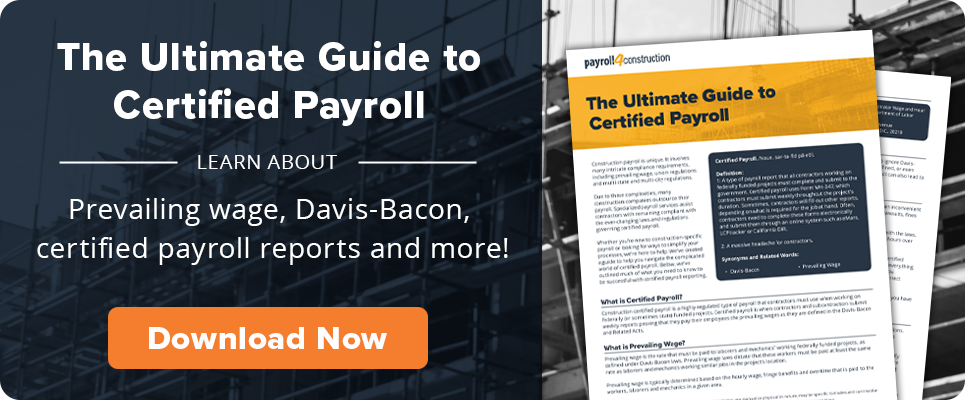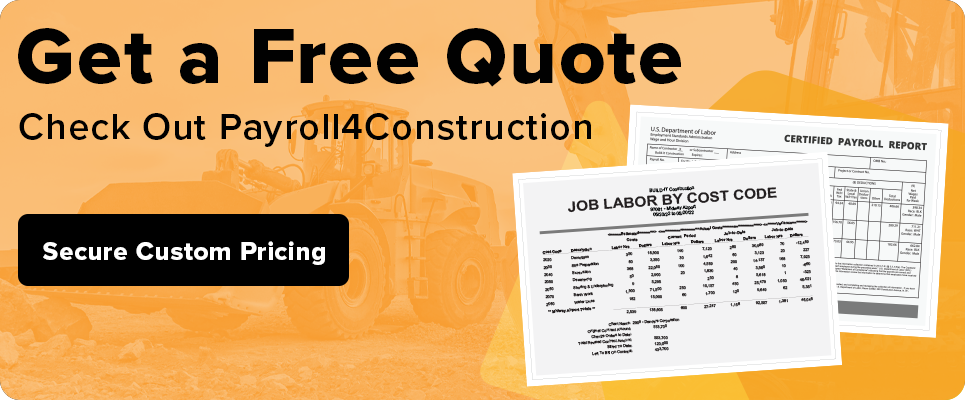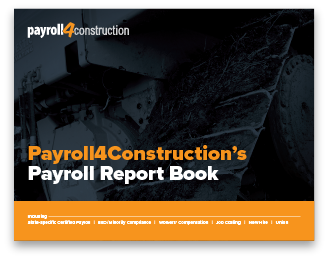
May 31, 2022
Payroll — with all the reports to run, and tax regulations to stay on top of and prevailing wages to calculate (just to name a few!) — can get messy.
That’s why we’ve put together a Definitive Payroll Glossary to help you better understand what’s involved as you work your way through the complexities of your next pay run!
Affordable Care Act (ACA) – A law that requires specific individuals and companies to gather information regarding the health care coverage of their employees throughout a year. These reports are then submitted to the IRS to verify that the minimal essential coverage is being met. Impacted parties include individuals enrolled in the marketplace, large companies with more than 50 employees, and employers who sponsor self-insured coverage.
Accrual – To increase or accumulate. This can be used when referring to accumulating paid time off, incurring expenses or earned revenue.
Automated Clearing House (ACH) – The primary system for electronic financial transactions in the United States. A computer-based network that processes large credit and debit transactions between banks and other institutions. Some examples of ACH services include direct deposit and tax refunds.
Amended Rate Notice – A written notice given to employees detailing their adjusted rate of pay.
After-Tax Deduction – An amount of money that is deducted from an employee’s post-tax income. An after-tax reduction reduces the net pay so an individual’s tax burden is not lowered. Examples include retirement funds and wage garnishments.
Arrears Payroll – A type of delayed payroll schedule; there is an interval of time between the pay period and the pay date. Each pay period represents last week’s payroll as opposed to the current payroll. Payroll in arrears allows for accuracy of hours.
Back Pay – A payment from an employer to an employee for money owed. The reasons for back pay include unpaid overtime, minimum wage violations, accounting errors and an unfair termination. The back pay amount is the difference between the hours paid and the hours unpaid.
Base Rate Pay – An employee’s standard rate of pay before any number of deductions are withheld or bonuses are added. Base Pay is expressed as an hourly, monthly or annual rate.
Bonus Taxes – A bonus is an amount of money that is added to wages. The bonus is considered a supplemental income and is taxed independently of the employee’s usual paycheck. The tax is a flat rate of 22%.
California Department of Industrial Relations (Ca DIR) – A department of government that works to pass legislation and implement regulations to protect and improve the health, safety, and economic welfare of labor force workers.
Cafeteria Plan – A of benefit plan in which employers offer their employees the opportunity to select a variety of pre-tax benefits. These benefits are deducted from an employee’s gross pay before taxes are withheld, increasing their take home pay. A cafeteria plan is outlined in Section 125 of the Internal Revenue Code.
Certified Payroll – A weekly report submitted by contractors working on federally-funded projects proving that they are paying their employees the prevailing wage. The report is submitted using a WH-347 form.
City / Local Income Tax – A type of tax local governments will enforce on people who live or work in the area. This tax is in addition to state and federal taxes. Localities who impose an income tax are in states that impose a state tax but not all states with state taxes have cities imposing local taxes.
Consolidated Omnibus Budget Reconciliation Act of 1985 (COBRA) – A law mandating the existence of an insurance program which provides former employees the ability to maintain health insurance coverage after leaving employment.
Court-Ordered Deduction (COD) – A government-issued order mandating employers to deduct a specific amount of money from an employee’s wages and send it to a creditor that has a judgment against the employee. Examples include child support payments and defaulted federal student loans.
Compensatory Time – A form of compensation given as extra paid time off to an employee that has worked more than their contracted 40 hours.
Compensation – The act of compensating an employee — with money or PTO — as a reward for some service or in account for some loss that has occurred.
Compliance Reporting – Reports indicating that an employer is adhering to the regulations imposed by the IRS and other tax entities as they pertain to the wages of their employees.
Contract Worker – An individual who contractually agrees to provide service or labor to a company in exchange for a fee or paycheck.
Current Payroll – A type of payroll system where the employee is paid the day the current pay week ends.
Davis- Bacon – A federal law that requires contractors working federally-funded projects to pay their employees the prevailing wage.
Direct Deposit – A banking transaction involving a payer making a monetary deposit directly into the account of the receiver of the payment.
Earned Income Tax Credit (EITC) – A refundable tax credit that helps low-to-moderate income working individuals by reducing the amount of federal taxes they owe.
Equal Employment Opportunity Commission (EEO) – A federal agency that enforces regulations which prohibit the discrimination of applicants and employees based on gender, age, race, color, sex, and national origin.
Electronic Funds Transfer (EFT) – The transferring of money from one bank account to another by means of an electronic network.
Electronic Federal Tax Payment System (EFTPS) – An electronic federal payment system used to pay federal taxes.
Employer Identification Number (EIN) – A nine-digit identification number assigned by the Internal Revenue Service that identifies a business for tax purposes.
Employee – An individual employed by a company for wages or a salary.
Employee Self-Service (ESS) – A web-based network of tools giving employees the ability to access relevant information and perform certain transactions on a centralized system.
Exempt Employee – An employee who does not collect overtime pay, nor do they qualify for minimum wage, because they earn salaried income and are on a professional or executive level.
Federal Income Tax – A tax on yearly earnings for individuals, businesses, and other entities that pay for a variety of government services.
Federal Insurance Contributions Act (FICA)- A federal payroll tax deducted from each paycheck that contributes to social services such as Social Security and Medicare.
Fair Labor Standards Act (FLSA) – A law that created the right to a minimum wage and overtime pay, while also establishing mandatory recordkeeping and child labor standards.
Form 940 – An annual report that companies must file to determine the amount of unemployment tax the company must pay on a federal level.
Form 941 – A quarterly report that details all the incomes taxes, Social Security taxes, and Medicare taxes withheld from employees’ paychecks.
Fringe Benefit – A form of non-wage pay or compensation provided to employees for their performance of service. Examples include health insurance, life insurance, and tuition reimbursement.
Federal Unemployment Tax Act (FUTA) – A federal law that imposes a payroll tax on employees’ wages that gets paid by the employer. This tax goes into funding unemployment systems on the federal level.
General Ledger – A bookkeeping ledger used to track all a company’s transactions.
Geofencing – A location-based service that uses cellular service to monitor an employee’s location while they’re on the jobsite. The employee and employer are alerted whenever the employee enters or exits the geofenced perimeter. This method of tracking helps reduce timesheet errors and frauds as both parties are immediately made aware each time an employee starts and ends their workday.
Gross Pay – The pay an employee earns before any taxes, benefits and garnishments are deducted and withheld from the paycheck.
Hourly Employees – A worker who is paid a specific dollar amount for each hour worked.
Income Tax Withholding – The amount of federal tax withheld from an employee’s paycheck during each pay period.
Independent Contractor – A self-employed individual who is contracted to provide or perform a service for another entity without being an employee. An Independent Contractor uses a 1099 form when filing their taxes.
Internal Revenue Code (IRC) – The main body of law that regulates all federal tax laws including estate, income, excise, tobacco, and employment taxes.
Internal Revenue Service (IRS) – The tax collection agency for the United States. Their job is to collect federal taxes and enforce the tax laws as set by the IRC.
Labor Burden – The cost of a company to have an employee that does not include actual wages. These costs can include pensions, payroll taxes, and types of insurances if paid for or matched by the company.
Minimum Wage – The lowest dollar compensation that an employer can legally pay their workers. Anything below this amount means the company cannot sell their labor.
Multi-State Payroll – The same payroll process of calculating, withholding and paying but in multiple states. This occurs when a company or an employee work in more than one state.
Net Pay – The employee’s wages that remain after all deductions and taxes are considered. Also referred to as take-home pay.
New Hire Reporting – A report given by the company to the state government detailing the information of a new hire or rehired employee.
Non-Exempt Employee – An employee that is entitled to earning overtime pay after working beyond the 40 hours.
Overtime – Time worked that is past what is contractually expected.
Paid Time Off (PTO) – The time an employee can take off from work while still receiving their regular wages for that time. PTO encompasses any type of leave such as sick, vacation and personal.
Paycheck – A payment in the form of a check, given to employees for time worked.
Payroll – A company’s system for paying their employees which includes tracking hours worked, calculating payment — including used PTO — and dispensing paychecks by direct deposit.
Pay Periods – The time frame an employer uses to track their employees’ hours, calculate wages, and determine when they receive their paycheck.
Pay Stub – A document associated with a paycheck that details how much the individual is paid while also itemizing deductions and detailing amount of remaining PTO.
Pre-Tax Deduction – Money that is deducted from an employee’s pay before any taxes are withheld. An employee will then have less in taxable wages. Pre-tax deductions can include retirement funds and health insurance.
Prevailing Wage – The base hourly rate paid to most workers employed on federally funded projects based on the wage that the same specification of worker earns in the locality of the project.
Salaried Employees – A worker who is paid a fixed amount of money each pay period for time worked.
Shift Differentials – The extra compensation paid to employees who work undesirable shifts or obscure hours.
Social Security – A government program that provides monetary assistance to those who receive low-to-no income and is collected as a tax that is imposed on both employers and employees at a rate of 6.2% respectively while independent contractors pay 12.4%.
State Tax – Also known as an Income Tax, this is a tax collected by the government of the state in which the worker lives.
State Unemployment Tax Act (SUTA) – A law that imposes a tax on employers to pay into the state’s unemployment fund on behalf of their employees.
Taxable Wage Base – The maximum amount of income an employee earns that is subject for Social Security taxing.
Timecard – A data sheet or card used to track the amount of time an employee works during a certain period by recording what time they start and end each workday.
Timecard Signatures – When both an employee and an employer sign the timecard, agreeing that the hours worked by the employee and the hours recorded by the timecard are matched and accurate.
Timesheet – A method for tracking how many hours an employee has spent working on a jobsite.
Tip Credit – A method for employers to include gratuities in the minimum wage calculations for their employees. Tips can be credited as a portion of the wage.
Trades – Occupations that require a specific skill set learned through advanced, specialized training that tend to be more manual in labor.
Trade Classifications – A way to individualize each trade by using their service as their identification. Examples of trade classifications include plumber and electrician.
Union Reporting – A union governed by the U.S. Department of Labor must submit annual financial forms disclosing their assets, receipts, disbursements, and liabilities.
Variable Pay – A type of bonus pay not included in the regular wage. This pay is received as compensation determined specifically by a worker’s sales performance.
Wage Garnishments – A court-order mandating that a portion of an individual’s wages must be withheld by the employer to be paid towards a debt such as child support.
Wage Tables – A data sheet used to determine employees pay rates based on varying categories. Categories include type of work being performed, type of project being worked on, and tenure with the company. A wage table is a useful tool when tracking prevailing wage.
WH-347 – The form used by contractors to submit certified payroll.
Withholding – Amounts deducted from an employee’s gross paycheck for varying tax purposes such as the Federal Income Tax and the State Income Tax.
W-2 – The tax form used in the United States that individuals use to report their yearly wages earned and the taxes paid on them.
W-4 – A tax form used by an employee to indicate their tax situation to their employer so that their employer can calculate how much income tax can be deducted and withheld from the employee’s pay.
401(K) Plan – An employer-sponsored retirement account that an employee can contribute a set amount of income into each pay period.
401(K) Match – An employer pays a certain percentage into an employee’s 401k based on the employee’s annual contribution.
1099 – A collection of tax forms completed by self-employed individuals to report their annual income and the taxes they deducted and withheld. These forms report the wages the individual earned at each project they worked in the year.
Share Article
Keep on current news in the construction industry. Subscribe to free eNews!



